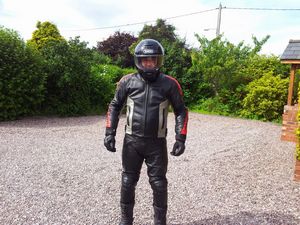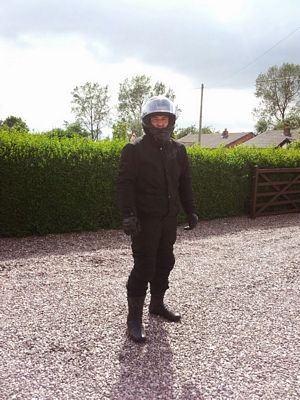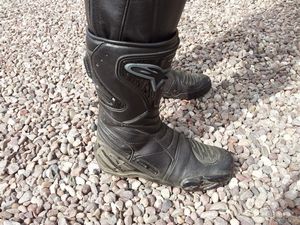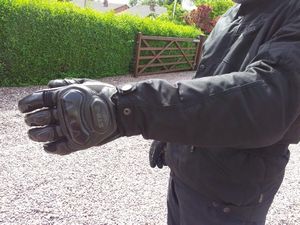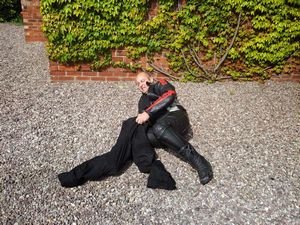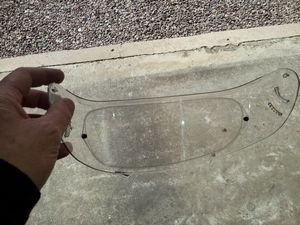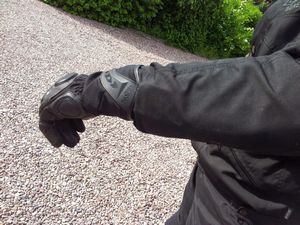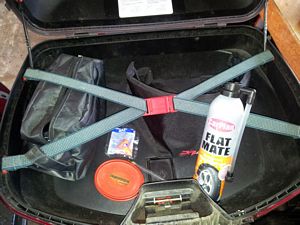|
By accessing/using The Crittenden Automotive Library/CarsAndRacingStuff.com, you signify your agreement with the Terms of Use on our Legal Information page. Our Privacy Policy is also available there. |

All Geared Up - How To Choose The Right Motorcycle Gear
|
|---|
|
|
All Geared Up - How To Choose The Right Motorcycle Gear
Colin Hubbard
Speedmonkey
July 11, 2014
In 20 years on and off riding a motorcycle I have probably ridden 20,000 miles, but 10,000 of those were in 2012 when I decided to take the car off the road to hone my riding skills in all weathers. If it rained or shined I had no option but to get togged up and onto 2 wheels to get to work or wherever I needed to be.
This experience teaches you a lot a lot about vehicle control and very importantly about what gear is required to keep you warm, dry or cool depending on what the weather has thrown at you that day.
When you first take your test or indeed any additional training which I have done (IAM course is well recommended!) they don’t give you any advice about what to wear or how to wear it. I have found that reading bike magazines can help a little. Ride magazine regularly carry out long term detailed and scientific tests on all sorts of gear.
Whilst this is helpful you also have to remember that every human is a different size so even when ordering recommended clothing off the internet it might not fit and you end up living with it - either too big or too small, thinking it will ‘give’ a little when used. In addition it's very expensive to kit yourself out in recommended gear and to buy all new, you could easily leave a shop having spent four figures on your credit card.
Motorcycle clothing has two main purposes;
1 - to protect you should the unthinkable happen and you end up sliding down the road at 70 miles per hour, into a kerb, or even under a car, so it is generally made from leather, which has excellent abrasion resistance, and armour, to cushion impacts on vulnerable parts of the body, or parts that will take an impact such as shoulders, elbows and knees.
2 - to protect you from the elements by keeping you warm and dry so your mind is focused on your riding rather than cold/wet parts of your anatomy.
It is regarded that motorcycle clothing should be a snug fit so the armour doesn’t move in the event of a fall. It is worthless if it is not positioned in the area it is intended to protect.
Let’s start with your helmet, which serves to protect your most important commodity, your brain. Without your grey cells working propely you fail to operate. In an impact your brain moves in your skull. The helmet shell protects your skull from impact and the padding stops your head moving within the helmet. You need to cushion your skull from impact and stop your brain moving too much in your skull which causes brain damage. Scary stuff hey. Do it right and do it properly.
First off always buy new and always ensure it fits right. Go to the motorcycle clothing shop. Try many different makes on as they all fit slightly differently. Take advice from the salesperson to ensure it fits properly as it’s better to be tighter and give a little than slightly loose and loosen up too much.
At this point you will end up with red ears from trying on lots of helmets but believe me it’s worth getting it right. If it’s not comfortable move on to the next. Remember, a better fit is vastly more important than an expensive helmet but try to get the most expensive you can afford as generally the more you spend the better quality materials and testing it has had.
If you like a specific helmet from the larger manufacturers such as Arai and Shoei they can sell different padding to ensure the one you like fits properly. If you still want to save money go find and buy the same helmet you like on the internet, knowing it will fit.
Now you have it look after it. Don’t drop it as the shell gets damaged easily so if you do have an off it will not do the job it was designed to do. Even if it drops off your bike seat a helmet will lose strength. Think of an egg shell breaking - once damaged it is visibly damaged and weakened but a motorcycle helmet doesn’t show its shell is weakened - another reason for not buying secondhand as you do not know the history. So don’t leave it on your bike seat or tank when on its side stand and keep a location at home or work where it's flat, dry and safe. I keep mine in my top box when out as it can’t fall from there.
Next up is the jacket and protecting the second most important item on your body – your core. You need to be warm at all times otherwise you could ultimately lose concentration and experience numbness, pain, drowsiness and weakness which will massively affect your ability to ride safely.
Leather or textiles are your down to personal choice. I have both and use the textiles for cold wet weather as leather isn’t waterproof. Ensure there's armour in the shoulders and elbows and you can move around freely in it. Your choice of bike can also dictate what you wear, not just in fashion but in design. For example a sportsbike with bars and seat at pretty much the same level is the perfect environment for one piece leathers as if you were to wear separates you might get plumber's crack and rain running down your undies.
For a leather jacket try to keep it a tight fit so the armour stays where it’s designed to and just enough room for a couple of light layers underneath. For textiles I bought mine with a slightly bigger fitment so I can get some more layers underneath as I wear this when it’s colder. The armour's still in the right place but I am warm.
In warm weather leather jackets have vents to open to let some cool air in and you can open the main zip a little, not a lot as you want it to stay on you in the event of a tumble.
Note - outside pockets aren’t waterproof so don’t put phones, wallets, cigarettes in them if you want to keep them dry. Instead use an inside pocket, which should be waterproof.
For trousers try to buy the same make as your jacket so that they zip into each other at the waist. This makes a massive difference for keeping in the heat and also safety as they hold together in the event of an off. Again look for armour on the knees and also the shins and look for some padding on the hip. I wear my leather trousers all year round and use overtrousers if it rains.
Motorcycle Boots offer protection not just to your feet but your ankles and calves - areas which could get injured very easily by a car or low wall. Firstly ensure they are not too big for you and could come off in the event of an accident when the socks you are wearing would end up being your only protection.
As with most items of clothing try these on at the shop. Whilst motocross boots look mean they are very rigid and make changing gear on a sportsbike very difficult. I bought some Alpinestars size 9 off the internet after trying some size 9’s on in a shop. When I put them on they were very tight. It turns out I bought the waterproof ones with a gortex liner which made the boot a tighter fit. A good tip to break boots in is to go for a walk in them. I walked the dog out in mine every night for a week and they soon gave a little. It took 6 months to get them to a comfortable fit though.
You can buy the best boots in the world that have been proven to be 100% waterproof but you must remember that there is always a large hole in the top where you put your feet in. I have been caught out many times in heavy rain when the water runs down your leg and into your boot and they act like a tank to collect water. Not fun. Now I carry some simple overtrousers and when I suspect it may rain I pull over and put these on, their main purpose being to divert water over the top of the boots so my feet remain 100% dry.
For any bikers out there who have struggled to put on waterproofs quickly and with your boots on at a bus stop ensure you keep a plastic shopping bag with you. Simply step into the bag with one boot and hey presto the waterproofs slide over your boot like a warm knife through butter, transfer the bag to your other boot and in 60 seconds you have your waterproofs on. The bag ensures theres no abrasion on the rubbery boot surface for the grippy inside of the overtrousers to catch on and you stay upright rather than tripping up and ending up sat on the floor. Been there done that!
Gloves, you can’t have enough pairs of gloves as they get dirty, wet and you often try different ones depending on summer or winter in a bid to keep your fingers from freezing or overheating. I try to look out for ones with some carbon or Kevlar protection on the knuckle, not just do they look purposeful but they also offer good protection to your knuckles which is the most likely place you will get any injury as you cling to your still beating bike flying sideways down the road. As I ride through most months in varied weathers I look for gloves that are longer in the wrist area which offer more weather protection as you don’t want to get your fingers wet as the padding starts to go out of shape and the seams move so they are uncomfortable.
My top tip for gloves is to ensure they are positioned inside your jacket whenever it’s looking like rain, when it rains the water pours down your arm and into you gloves and they fill up like a balloon under a tap and you lose what feel you had over your minor controls. Unless you ride a chopper with huge cowhorn handlebars you are always better off tucking your gloves inside your coat and zipping it up to ensure a snug fit, I have never experienced wet arms from water going between gloves and coat this way. On a personal note my right coat sleeve is harder to fasten so I do zip the right one up first and then the left using my right gloved hand. It’s trial and error to whatever suits you.
For anyone out there who doesn’t have a
snood I would recommend the next thing you do is get on line or to your nearest shop and try one. They bridge the gap between your coat collar and helmet and act as a plug to stop wind getting down your jacket and making you cold. In addition they stop the rubbing you get from abrasive coat collars. When it’s really cold I use 2 to really keep the drafts out. I have an Oxford one which is better made than the other non-branded one and keeps its shape better. As mentioned I have 2 and rotate them weekly, washing when not in use to regain their elasticity, oh and also smell nicer.
With regards to
waterproofs it’s best to wear proper textile tested to destruction and monsoon type weather clothing but not everyone has the funds to have both leathers and textiles. My experience has shown me that normal waterproof overtrousers and waterproof overjacket over your leathers can work well to keep the wet away and keep you dry until you get home. The main places where you get wet are in the boots from the rain running down your leg, in the crutch from water running off the tank and collecting just in front of you and your neck where the top of your jacket meets your helmet. I tried a 1 piece rainsuit on numerous occasions which was a nightmare to put on over leathers and in the end bought a simple 2 piece oversuit which is perfect as a temporary measure.
The last item of clothing on the list and is easy to forget is
undergarments - thermals, mid layers and base layers. The base layers are designed to draw sweat from your skin, known as wicking and also act as an insulating layer. These are generally a thin elasticated long sleeve top and separate ‘long johns’ and cost circa £25-30 each. Mid-layers are a thin compacted fleece material which offers wind proofing and heaver insulating properties and are long sleeve tops with a slighty higher collar. You can also get ‘Long-Johns’ as midlayers but these are for more severe conditions than we have in England. The final layer top is a fleece to add extra insulation to your core and help keep the wind off the base layers. The beauty of the laying system is that its not too bulky to wear under you existing coat and trousers so you can be comfortable and not too hot.
So now you have bought all the gear you now have to decide what to use on the day. Depending on your journey you should always think about how long you are out for, what the weather will do, where am I going and where can I stop. If its dry then it's leathers, and your choice of under layers. If its dry but you expect rain, why not put on your leather trousers and textile jacket and take some over-trousers in a tank bag. If its rain then it’s the full monty of waterproofing and I even put on my tankbag as it keeps the rain from running off the tank and pooling in the crutch region.
Now think about how you wear the items. Do I need to open the vents, close the vents, do the main zip all the way up or leave open a little for fresh air? Do I need to open my helmet vents to let in fresh air or is rain due and the rain will get into the helmet, it then stays wet and can get mouldy.
If you have a black visor for really sunny days (when it’s quite frankly dangerous to ride with a clear visor) then always carry a clear visor in case the weather turns or the police pull you over. Black visors are illegal for road use even though you have better and safer vision that wearing sunglasses so be on your guard and keep the excuses at the back of your mind ‘well officer it is a perfectly clear sunny day and I thought it safer to wear this visor than my clear one to protect my eyes from the sun. If the weather turns I can quickly swap to my clear visor which is here in my top box!’
Note I experience misting up issues last year and found the pinlock system on my Shoei (or a fog insert product) to be a fantastic solution, it works by keeping a screen of plastic about 1mm away from the visor inside and it acts like double glazing, it simply doesn’t mist up. My black visor steamed up in cold weather, mornings, and in the rain as it didn’t have a pinlock or fog-guard. No matter what products I used on the inside it steams up in certain conditions if you do not have a fog insert. Seriously consider getting a fog insert or pinlock system if you ride a lot, it really could save your life.
Riding in the rain can be tricky and on the subject of visors I would heavily promote a rain repellent so that the rain beads off your visor. Light mist can be difficult to see in but with the rain repellants sprayed and wiped clean regularly on your visor you simply turn your head and the water runs off.
Often when I go on a journey there’s something which annoys me. Maybe my jacket isn’t done up enough, I have left a pocket open or I didn’t put on overtrousers when it was looking like rain. At this point I think WHY DIDN’T I just do this or do that? Now at the start of a journey I think WDI before it happens, then think about the weather, where I’m going and then look at buttons, vents pockets, zips, visors and then set off happy that I’m going to be happy. Why don’t you try that next time you go out!
With all of the above put into practice I hope you can stay warm and dry but
I have listed below a few additional tips:
1 - When you buy new gear, always keep the old gear in case of emergency. If for example the heavens open and you get soaked to the skin, if you have kept your old gloves, boots, leathers you can wear them the next day whilst your wet gear dries out. Wet gear can take days to dry out.
2 - Don’t dry out motorcycle clothing on radiators. Leave to naturally dry in the house over the back of a chair or window sill. Heat dries out and causes cracking which in the long term damages leather.
3 - If you really can’t keep your hands warm with just gloves then try heated grips. They can be bought from just £40 and are fairly easy to fit and make the world of difference when the weather is freezing or just when wet.
4 - If you ride on a daily basis seriously consider a top box, they allow you to safely and securely take items/shopping with you and at the other end store your helmet, gloves etc so you don’t have to walk around with them. In addition put a toiletry pack inside and keep essentials such as a tin of tyre weld, a pen, baby wipes and a side stand plate to stop you sinking in the mud when you haven’t got an old beer can.
Thanks for reading and if you have any tips please add as a comment.


















